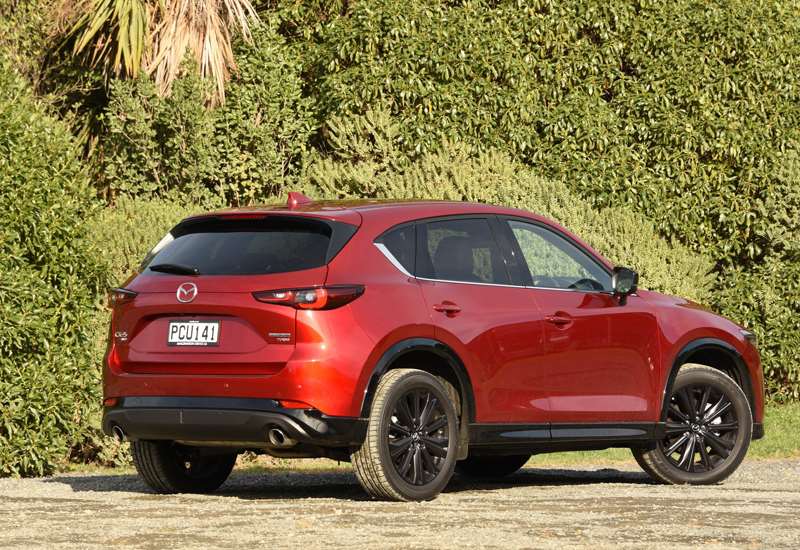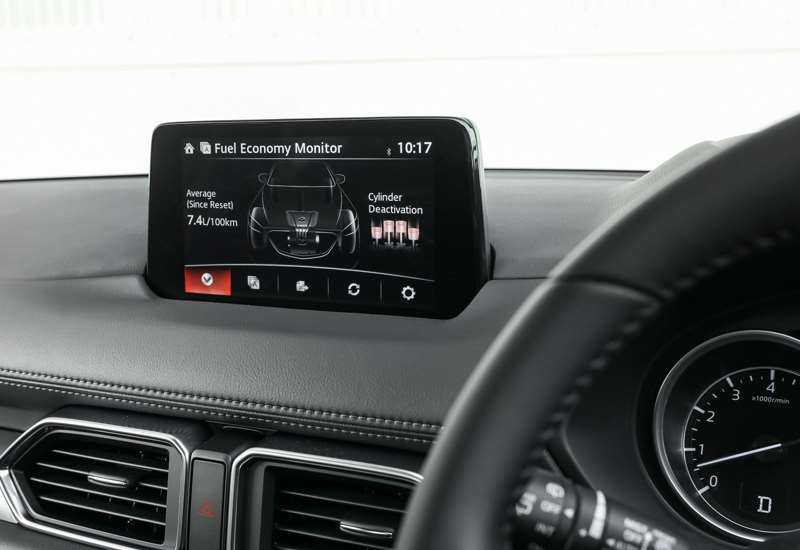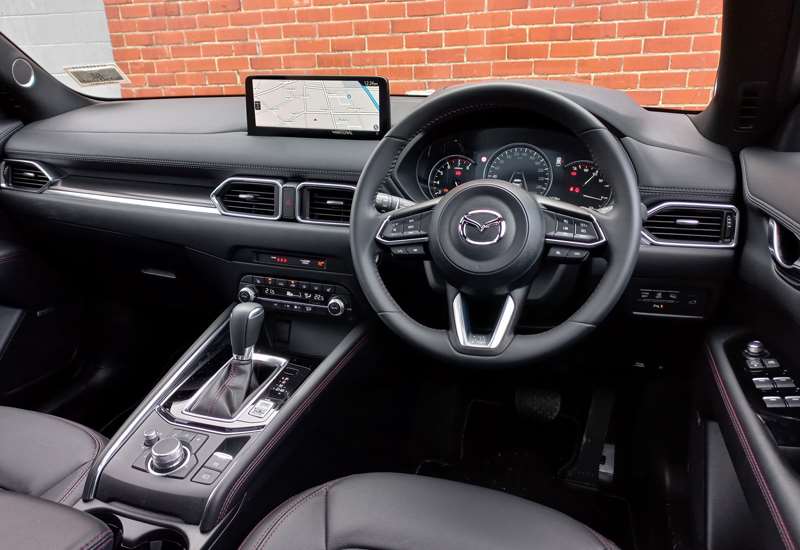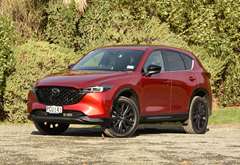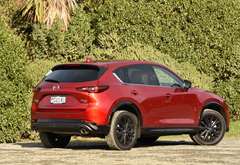Mazda’s most popular new car has been updated. David Thomson has been spending time behind the wheel.
WHAT’S NEW?
After several especially strong years, Mazda seem to be doing it tougher for sales in 2022; seventh amongst the brands year-to-date with 4% new car market share, down from fifth place with a 6% presence in 2021.
While the CX-5 remains the Hiroshima company’s top-selling vehicle, it too has slipped down the ranks and out of the top 10 so far this year, in the face of a raft of mid-sized SUV competitors, including all new models, and a few updated ones too.
The CX-5 is, itself, one of the updated models, the current second-generation machine having been refreshed for 2022.
The facelift includes visual changes front and rear, interior updates, and suspension tweaks across the range, plus a new off-road drive mode for the flagship Takami variant and the Activ variant, the latter being a new addition to the range.
Familiar from before are the choice of three pure-petrol four-cylinder engines, comprising a 2.0-litre 115kW/ 200Nm mill for the front-drive variants, a 140Nm/252Nm 2.5-litre unit as the mainstay of the four-wheel-drive line up, upgraded with a turbo to deliver 170kW/420Nm for the SP25T and Takami versions. A six-speed automatic transmission is matched to every engine choice.
A decision to drop a diesel option from the revised line-up looks like a good call given the stuff is now close to matching 91 octane petrol for pump price, and there are road user charges to be covered too. The absence of a pure electric or hybrid choice doesn’t seem quite as sharp, though, to be fair, the MX-30 is Mazda’s current pitch for a share of that particular pie and, even if Mazda NZ had wanted a battery-propelled CX-5, they would have been out of luck as there is no such thing globally; a roughly equivalent option, the new CX-60, is due for launch here in mid-2023.
Mazda served up a double-act for this appraisal, with time behind the wheel of the $47,990 GSX AWD followed by a stint with the $61,290 SP25.
WHAT COMES AS STANDARD?
Key safety items across the updated CX-5 range includes radar cruise control, lane keep assist, autonomous emergency braking, blind spot monitoring, rear cross traffic alert, auto-dipping headlights, and tyre pressure monitoring. The GSX takes rear autonomous emergency braking, traffic sign recognition, driver attention monitoring, upgraded adaptive lights, and front and rear parking sensors. The SP25 adds a further adaptive light upgrade.
The GSX also ships with dual zone climate, leatherette and suede trim and a head-up display. Its 8-inch centre display screen is home base for an ICT system that includes satellite navigation, a six-speaker sound system, and smartphone mirroring (wireless with Apple devices).
The SP25 adds a clutch of extra kit, including a power sunroof, power tailgate, digital main instrument cluster, a larger 10.25-inch centre display screen, and 10-speaker Bose sound system. It also takes leather upholstery, and power operated and heated front seats.
WHAT DOES IT LOOK LIKE?
As is usual with a mid-life facelift, the updated CX-5 gets a restyled nose and tail.
The most obvious changes are upfront, where there is a new textured grille, revised bumper, and re-styled headlights. At the rear, there is a new tailgate, light clusters, and larger tailpipes. In combination, these changes and other minor tweaks give the updated CX-5 a tauter more contemporary look without drastically changing the overall form of the vehicle.
Sitting on black 19-inch, rather than silver 17-inch, alloys, the SP25 variant looks more sporty and firmly planted on the road than the GSX.
WHAT’S IT LIKE INSIDE?
At the time of its introduction, the second generation CX-5 set new standards – akin to the best European alternatives – for the quality of its cabin. Others have made ground on Mazda in recent years, but while no longer a clear leader for interior fit, finish and feel, the CX-5 is still up there with the best in class.
Of the two variants tested, the GSX looks and feels good inside, while the more expensive and better-provisioned SP25 feels great.
Both variants have a space-saver spare wheel under an adjustable boot floor. The boot maintains a 438-litre capacity with the floor in its lower position, expanding to 1340 litres when the rear seats are folded down. A 40:20:40 rear seat split is retained, with the ability to fold the centre armrest section down to gain load-through stowage capacity for skis, small loads of timber and the like.
The rear seats are comfortable and adequately roomy. Revisions to the design of the front seats are included as part of the update, but otherwise changes to the cabin are minor.
As was the case previously, the cabin scores well for practicality up front, with key controls and instruments clearly laid out, and plentiful storage spaces around the seats. Tech-wise, the SP25 feels contemporary with its 10.25-inch centre display screen and digital instrument cluster, but the GSX’s smaller 8-inch screen looks a bit dated.
WHAT’S IT LIKE TO DRIVE?
There was little to fault in the pre-facelift CX-5’s blend of ride and handling, so it is no surprise that Mazda has chosen to make only minor adjustments to the suspension.
The GSX was a thoroughly pleasant vehicle to drive, being light on the controls and responsive around town, accomplished when cruising, and decently mannered through tarmac twists and turns. It was also very sure-footed on gravel, with changes to the drive system that provide a higher proportion of the power to the rear wheels than before, giving it a positive and engaging feel.
Mazda has stayed old-school with the CX-5 sticking with a 2.5-litre engine and conventional six-speed automatic transmission (the latter is increasingly becoming an outlier as other brands adopt CVT transmissions).
Though CVTs are improving all the time, a conventional auto remains my preferred choice. In its non-turbo form, as fitted to the GSX, the engine is smooth and nicely matched to the transmission. That said, 140kW and 252Nm are not massive outputs to propel a vehicle of the CX-5’s size and bulk, and the motor is forced to work hard to maintain momentum on steeper pinches.
With its turbo version of the same motor mustering 170kW and 420Nm in turbo-guise, the SP25 is a different kettle of fish altogether, being notably more responsive in all situations. Extra power comes, though with a direct cost; the GSX’s 7.4l/100km fuel consumption means it escapes any form of penalty under the Government’s clean car discount scheme, whereas the SP25 – at 8.2l/100km – attracts a $1552.50 fee.
Sitting on wider, lower profile tyres, the SP25 also has edge when it comes to cornering grip and all-round handling balance, albeit at the expense of a little more road noise.
VERDICT
A gentle update was all the CX-5 really needed to maintain its standing as one the country’s most accomplished mid-sized lifestyle SUVs, and that is exactly what has been served up.
- David Thomson

